Lenovo Legion Y740 17″ review – enjoy gaming, while being incognito
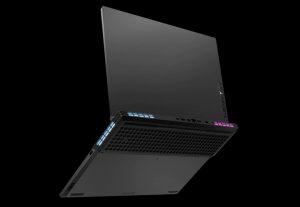 It wasn’t a long time ago when we tried the fresh out of the oven Legion Y740. It was the 15-inch version of the laptop and we were very curious to see the difference to the Legion Y730 and how the RTX graphics cards are going to put up against their predecessors.
It wasn’t a long time ago when we tried the fresh out of the oven Legion Y740. It was the 15-inch version of the laptop and we were very curious to see the difference to the Legion Y730 and how the RTX graphics cards are going to put up against their predecessors.
Now, things look settled down, with the RTX series by NVIDIA being on the laptop market for more than half a year. This means we can now compare the Legion Y740 to a wide variety of gaming laptops that house the same hardware. However, we decided that it would be more suitable to get the 17-inch version of the device, so to see if the larger amount of space is proportional to better cooling or not.
You can check the prices and configurations in our Specs System: https://laptopmedia.com/series/lenovo-legion-y740-17/
Contents
Specs Sheet
- HDD/SSD
- up to 2000GB SSD + up to 2000GB HDD
- RAM
- up to 64GB
- OS
- Windows 11 Home, Windows 10 Home, Windows 10 Pro, No OS
- Battery
- 76Wh, 76Wh, 4-cell, 57Wh
- Dimensions
- 412 x 305 x 21.95 - 25.45 mm (16.22" x 12.01" x 0.86")
- Weight
- 2.80 kg (6.2 lbs)
- Ports and connectivity
- 1x USB Type-C
- 3.2 Gen 2 (10 Gbps)
- 1x USB Type-A
- 3.2 Gen 2 (10 Gbps)
- 1x USB Type-A
- 3.2 Gen 1 (5 Gbps), Sleep and Charge
- 1x USB Type-A
- 3.2 Gen 1 (5 Gbps)
- HDMI
- 2.0
- Displayport mini
- Card reader
- Ethernet LAN
- Gigabit Ethernet
- Wi-Fi
- 802.11ac (2x2)
- Bluetooth
- 4.1
- Audio jack
- 3.5mm audio jack
- Features
- Fingerprint reader
- Web camera
- 720p HD
- Backlit keyboard
- optional
- Microphone
- Digital-array microphones
- Speakers
- 2x 2W
- Optical drive
- Security Lock slot
- NOVO hole
All Lenovo Legion Y740 (17″) configurations
What’s in the box?
First, we should note that the box, packing the Legion Y740 17″ is huge. You definitely won’t come unnoticed if you walk out of the store with it. Apart from the laptop itself, inside you’re going to find some paper manuals and second cardboard, containing the 230W power adapter.
Design and construction
This laptop boasts a mostly aluminum build, in contrast to the more wallet-friendly Legion Y540. Additionally, it weighs 2.80 kg (6.2 lbs) and has a profile of 23 mm – both very good figures for a 17-inch gaming laptop. Similarly, though, the top of the lid (where the Legion logo is located) glows when you start the device.
Probably as expected, the lid of the laptop opens easily with a single hand. We are happy, to see that the camera is located on its orthodox location, rather than below the screen as Lenovo did with their 15-inch version of the laptop. Additionally, the lid itself is pretty sturdy as it doesn’t bend too much when you apply pressure on top of it, neither does it flex excessively when you try to forcibly do so. Weirdly, though, the laptop has some pretty sizeable bezels all around its display.
Bigger even than those on the Dell G7 17 7790. Not to mention the ROG Zephyrus S GX701 that didn’t even have a camera. Nevertheless, it is always good to see a Number pad on the keyboard. It just makes it look more… finished. It also has a backlight and even optional RGB one. Well, it is not the most sophisticated keyboards on the market – its travel is short, while the feedback is not the clickiest on the market – below-average performance for a gaming device.
Let’s not forget the touchpad that is placed at a significant distance below the keyboard. However, it is responsive and fast, especially when paired with the 144Hz display.
As you can imagine, the Legion Y740 17″ looks like an enlarged copy of its 15-inch sibling. However, when we turned the device upside down, we were impressed by the size of the ventilation grill. Additionally, there are two speakers on the front side of the plate plus one subwoofer hiding behind the bottom panel.
Ports
As with the latest Lenovo Legion laptops, the Legion Y740 17″ has most of its I/O placed on the backside. There you’ll find the charging port, a USB Type-A 3.1 (Gen. 1) port, an RJ-45 connector, followed by a USB Type-A 3.1 (Gen. 2) port, an HDMI connector, and a DisplayPort. On the left and right side, respectively, are located a USB Type-C Thunderbolt 3 port and a USB Type-A 3.1 (Gen. 1) port.
Display quality
Lenovo Legion Y740 17″ has a Full HD 144Hz IPS panel, made by LG with a model number LP173WFG-SPD2 (LGD05E0). Its diagonal is 17.3″ (43.94 cm), and the resolution 1920 х 1080 pixels. The screen ratio is 16:9, and we are looking at a pixel density of – 127 ppi, and a pitch of 0.2 х 0.2 mm. The screen turns into Retina when viewed at distance equal to or greater than 69cm (27″) (from this distance one’s eye stops differentiating the separate pixels, and it is normal for looking at a laptop).
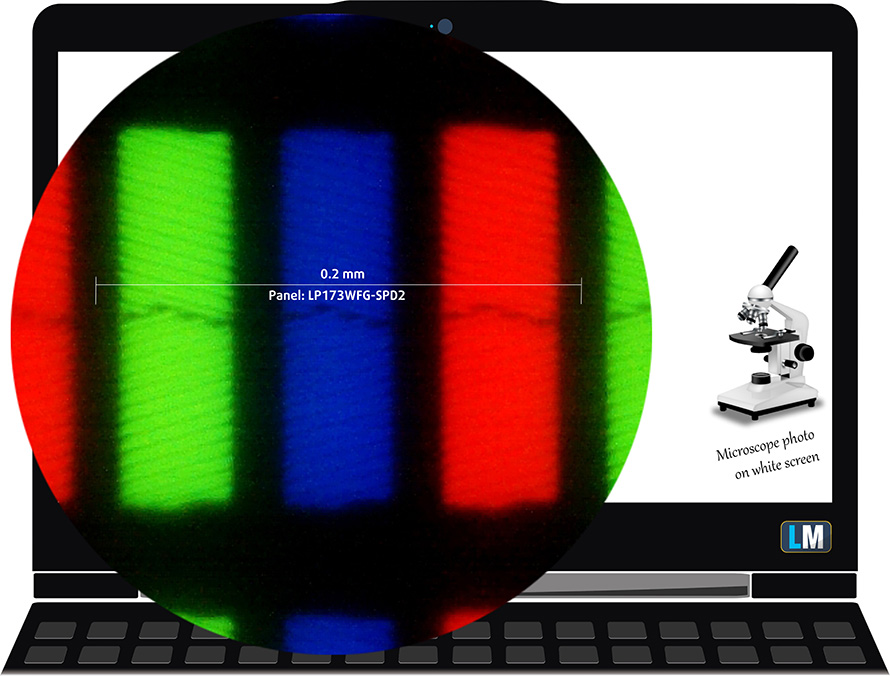
Viewing angles are excellent. We offer images at 45° to evaluate image quality.

The measured maximum brightness of 323 nits in the middle of the screen and 296 nits as an average for the whole area, with a maximum deviation of 13%. The Correlated Color Temperature on a white screen is 7650K – colder than the optimal for the sRGB standard of 6500K. The average color temperature through the grey scale before profiling is 7350K.
In the illustration below you can see how the display performs from a uniformity perspective. In other words, the leakage of light from the light source.
Values of dE2000 over 4.0 should not occur, and this parameter is one of the first you should check if you intend to use the laptop for color-sensitive work. The contrast ratio is fine – 1200:1 (1080:1 after profiling).
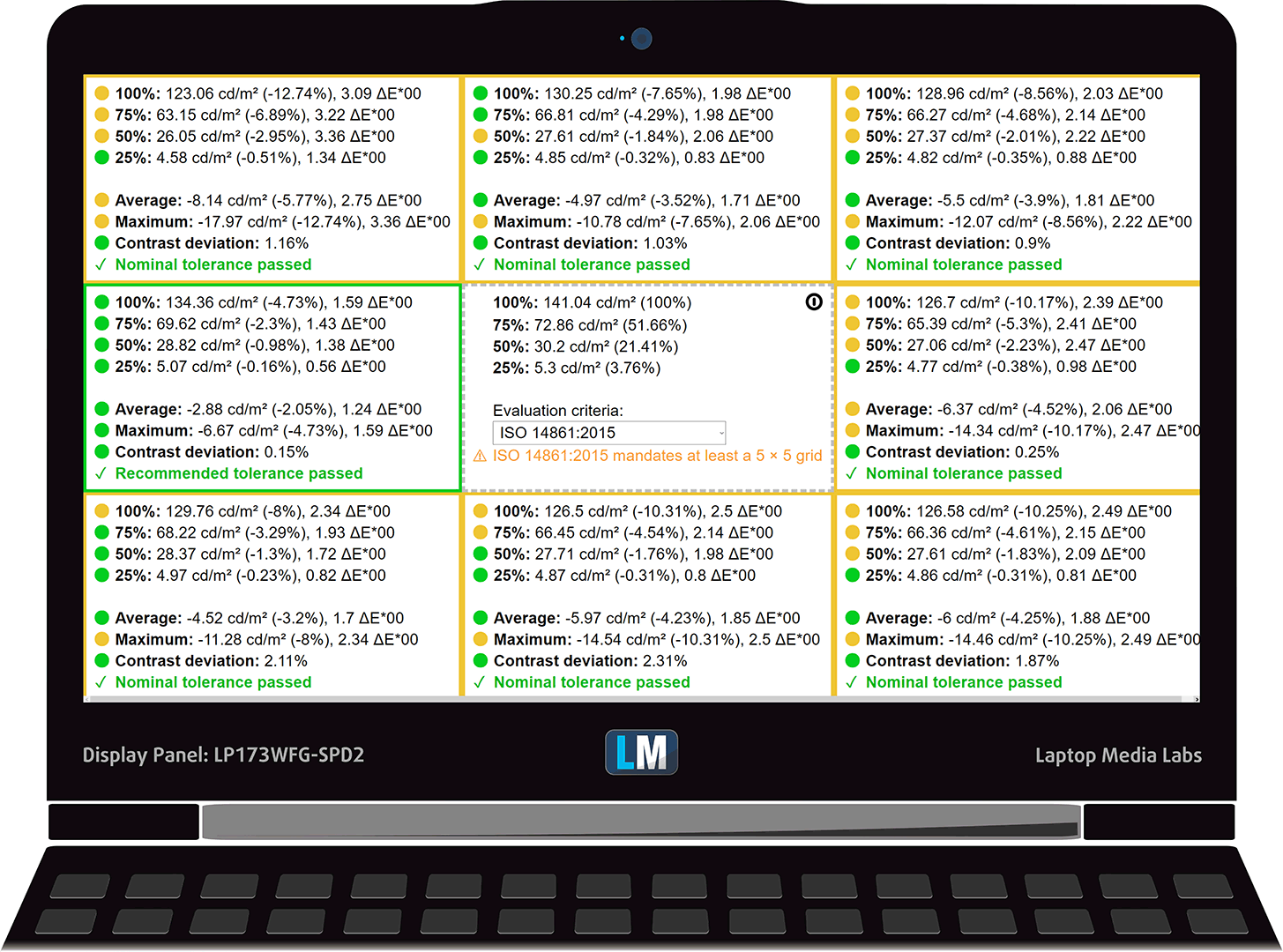
To make sure we are on the same page, we would like to give you a little introduction to the sRGB color gamut and the Adobe RGB. To start, there’s the CIE 1976 Uniform Chromaticity Diagram that represents the visible specter of colors by the human eye, giving you a better perception of the color gamut coverage and the color accuracy.
Inside the black triangle, you will see the standard color gamut (sRGB) that is being used by millions of people in HDTV and on the web. As for the Adobe RGB, this is used in professional cameras, monitors, etc for printing. Colors inside the black triangle are used by everyone and this is the essential part of the color quality and color accuracy of a mainstream notebook.
Still, we’ve included other color spaces like the famous DCI-P3 standard used by movie studios, as well as the digital UHD Rec.2020 standard. Rec.2020, however, is still a thing of the future and it’s difficult for today’s displays to cover that well. We’ve also included the so-called Michael Pointer gamut, or Pointer’s gamut, which represents the colors that naturally occur around us every day.
The yellow dotted line shows Lenovo Legion Y740 17″‘s color gamut coverage.
Its display covers only 96% of the sRGB/ITU-R BT.709 (web/HDTV standard) in CIE1976.
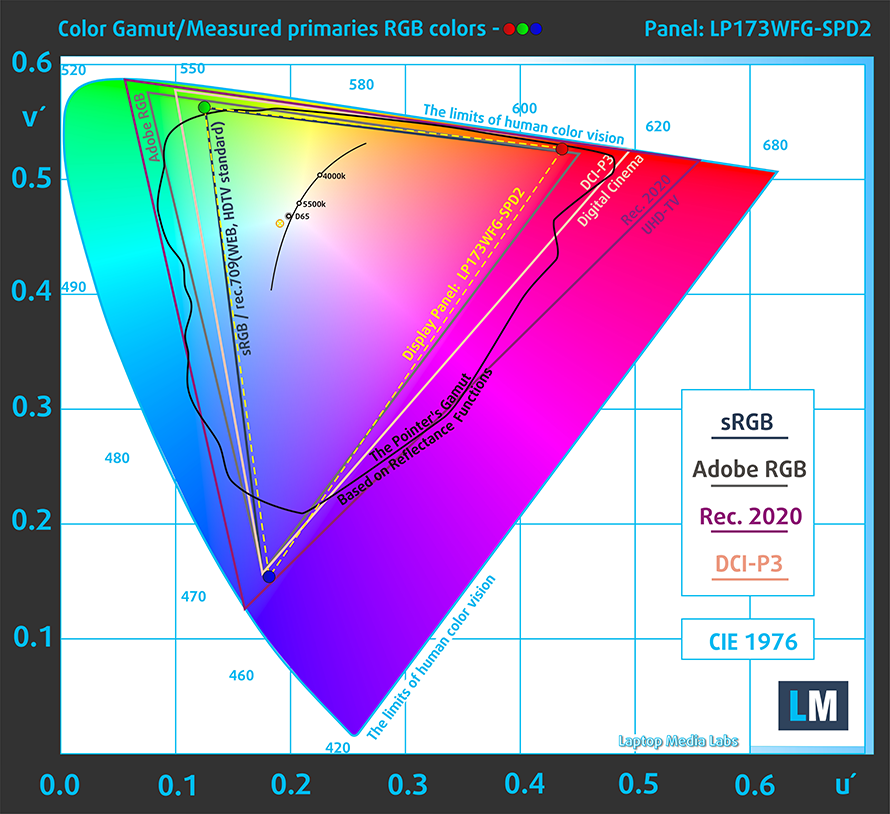
Our “Design and Gaming” profile delivers optimal color temperature (6500K) at 140 cd/m2 luminance and sRGB gamma mode.
We tested the accuracy of the display with 24 commonly used colors like light and dark human skin, blue sky, green grass, orange, etc. You can check out the results at factory condition and also, with the “Design and Gaming” profile.
Below you can compare the scores of Lenovo Legion Y740 17″ with the default settings (left), and with the “Gaming and Web design” profile (right).
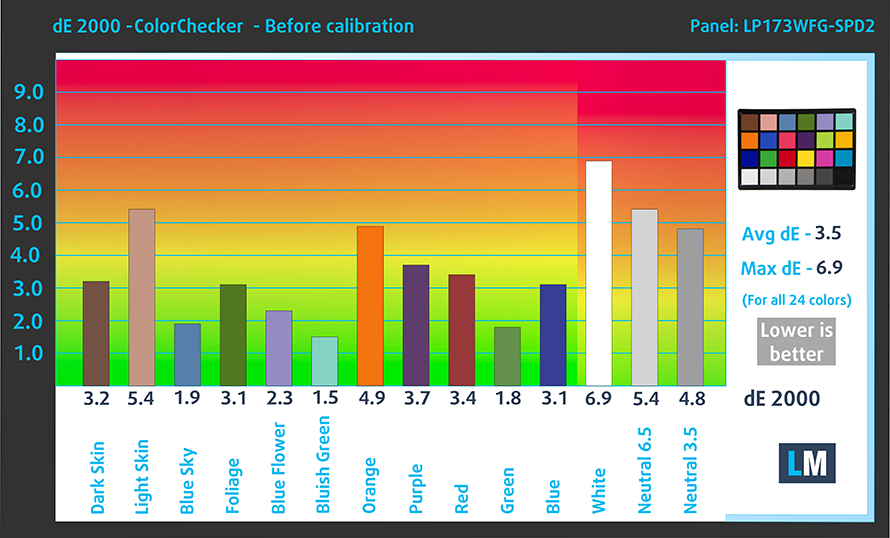
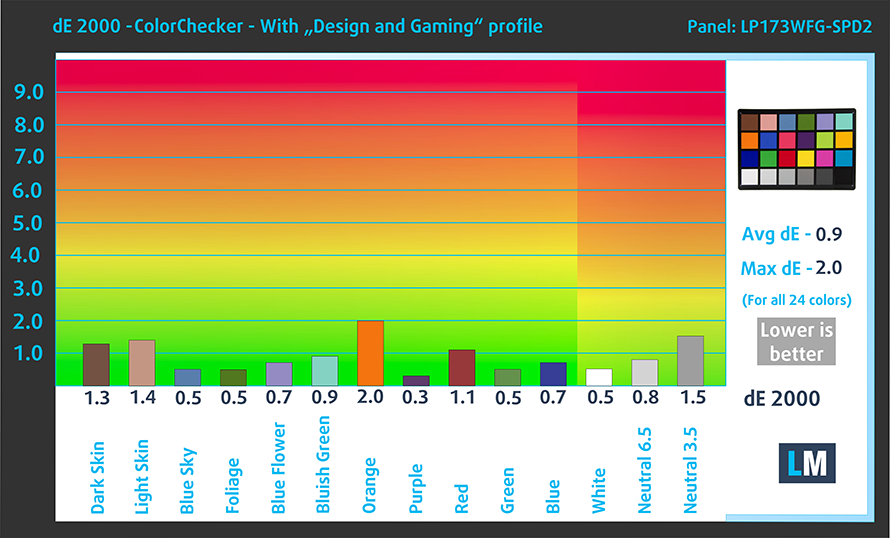
The next figure shows how well the display is able to reproduce really dark parts of an image, which is essential when watching movies or playing games in low ambient light.
The left side of the image represents the display with stock settings, while the right one is with the “Gaming and Web Design” profile activated. On the horizontal axis, you will find the grayscale and on the vertical axis – the luminance of the display. On the two graphs below you can easily check for yourself how your display handles the darkest nuances but keep in mind that this also depends on the settings of your current display, the calibration, the viewing angle, and the surrounding light conditions.
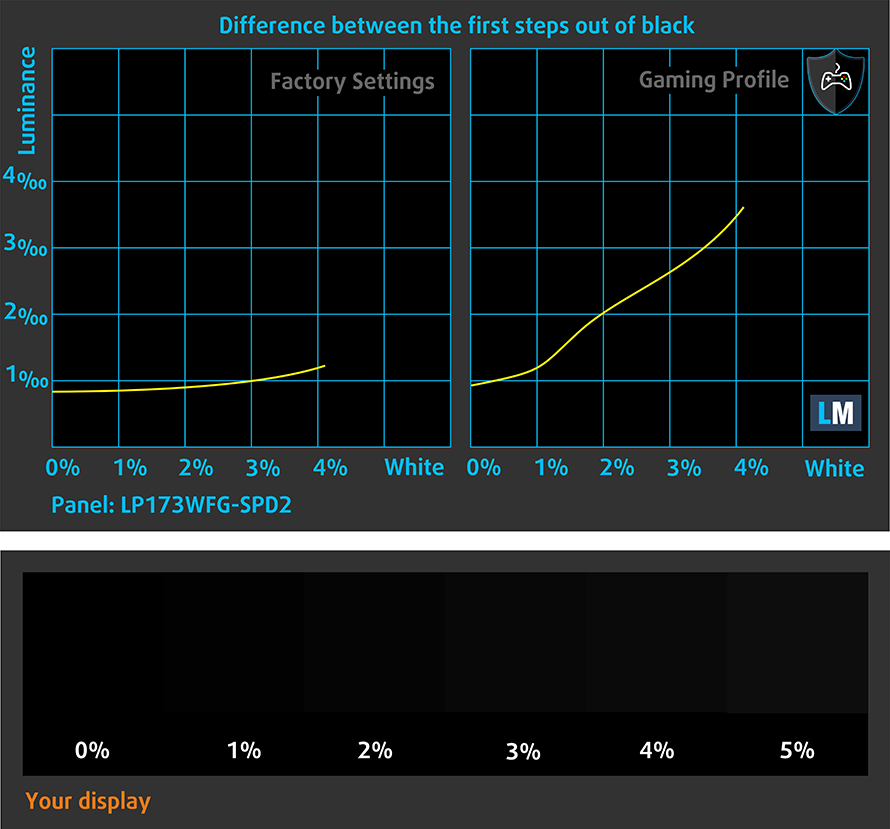
Response time (Gaming capabilities)
We test the reaction time of the pixels with the usual “black-to-white” and “white-to-black” method from 10% to 90% and vice versa.
We recorded Fall Time + Rise Time = 8.6 ms – one of the fastest panels out there.
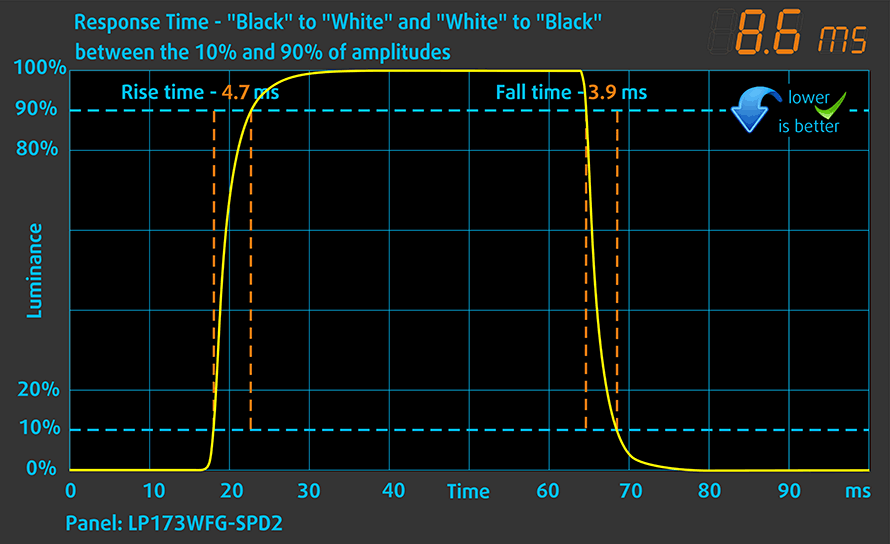
PWM (Screen flickering)
Pulse-width modulation (PWM) is an easy way to control monitor brightness. When you lower the brightness, the light intensity of the backlight is not lowered, but instead turned off and on by the electronics with a frequency indistinguishable to the human eye. In these light impulses, the light/no-light time ratio varies, while brightness remains unchanged, which is harmful to your eyes. You can read more about that in our dedicated article on PWM.
Lenovo Legion Y740 17″‘s display doesn’t use PWM to adjust its brightness at any level. This makes it comfortable for long periods of usage, such as a good gaming session or a night of eSports.
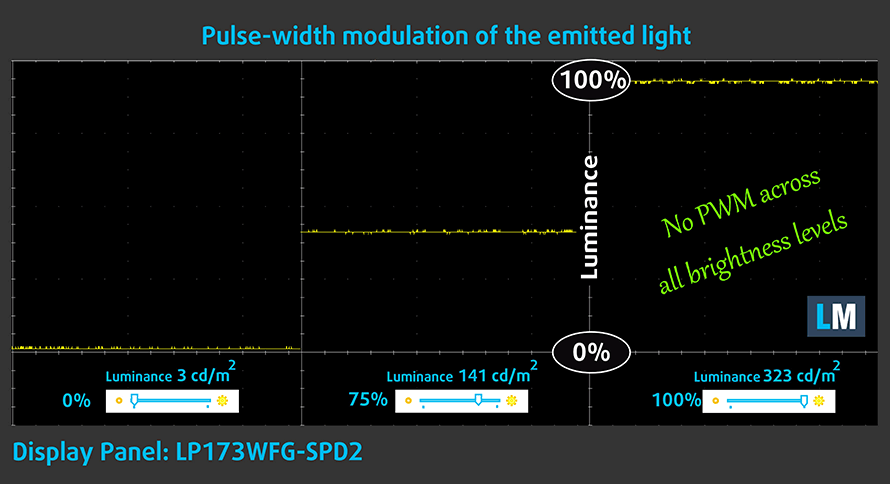
Blue light emissions
Installing our Health-Guard profile not only eliminates PWM but also reduces the harmful Blue Light emissions while keeping the colors of the screen perceptually accurate. If you’re not familiar with the Blue light, the TL;DR version is – emissions that negatively affect your eyes, skin and your whole body. You can find more information about that in our dedicated article on Blue Light.
Conclusion
Lenovo Legion Y740 17″ has a Full HD display with an IPS panel, 144Hz refresh rate – hence a fast reaction time, great contrast ratio and comfortable viewing angles. It also doesn’t use PWM to adjust its brightness levels and covers up to 96% of the sRGB color gamut. What is really interesting about this panel, however, is that when you push it a little bit to its limit (with our Gaming and Web design profile) it drops the average dE to below 1.0, which makes it extremely color accurate.
Buy our profiles
Since our profiles are tailored for each individual display model, this article and its respective profile package are meant for Lenovo Legion Y740 17″ configurations with 17.3″ FHD IPS LG LP173WFG-SPD2 (LGD05E0).
*Should you have problems with downloading the purchased file, try using a different browser to open the link you’ll receive via e-mail. If the download target is a .php file instead of an archive, change the file extension to .zip or contact us at [email protected].
Read more about the profiles HERE.
In addition to receiving efficient and health-friendly profiles, by buying LaptopMedia's products you also support the development of our labs, where we test devices in order to produce the most objective reviews possible.

Office Work
Office Work should be used mostly by users who spend most of the time looking at pieces of text, tables or just surfing. This profile aims to deliver better distinctness and clarity by keeping a flat gamma curve (2.20), native color temperature and perceptually accurate colors.

Design and Gaming
This profile is aimed at designers who work with colors professionally, and for games and movies as well. Design and Gaming takes display panels to their limits, making them as accurate as possible in the sRGB IEC61966-2-1 standard for Web and HDTV, at white point D65.

Health-Guard
Health-Guard eliminates the harmful Pulse-Width Modulation (PWM) and reduces the negative Blue Light which affects our eyes and body. Since it’s custom tailored for every panel, it manages to keep the colors perceptually accurate. Health-Guard simulates paper so the pressure on the eyes is greatly reduced.
Get all 3 profiles with 33% discount
Sound
Lenovo Legion Y740 17″ produces a very good quality sound from its speakers. Its entire frequency range is clear of deviations.
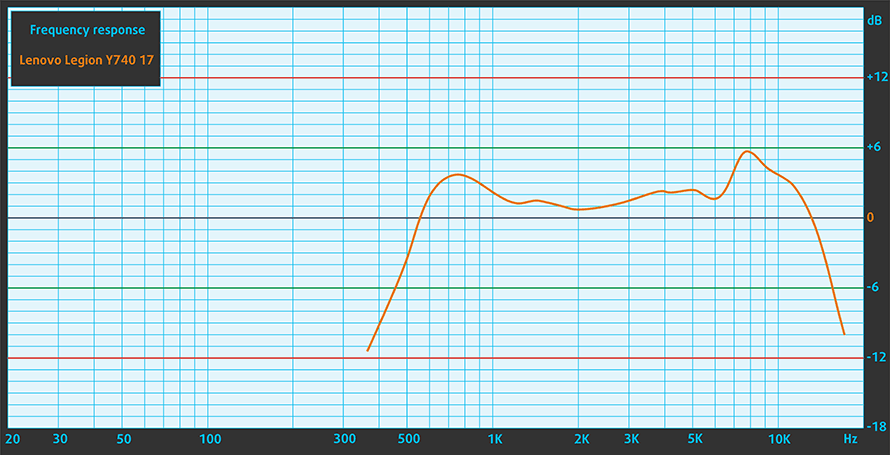
Drivers
Lenovo has all of the drivers and utilities available for download here: https://pcsupport.lenovo.com/us/en/products/laptops-and-netbooks/legion-series/legion-y740-17ichg
Battery
Now, we conduct the battery tests with Windows Better performance setting turned on, screen brightness adjusted to 120 nits and all other programs turned off except for the one we are testing the notebook with. Lenovo Legion Y740 17″ is equipped with a 76Wh battery – significantly larger than the one on the 15-inch version of the laptop.
However, battery life is still not great – we were able to get less than four hours of Web browsing and around three hours of video playback.
In order to simulate real-life conditions, we used our own script for automatic web browsing through over 70 websites.
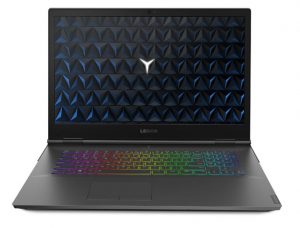
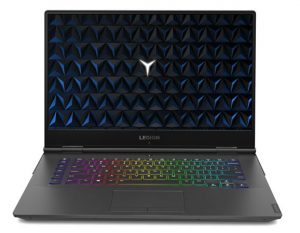
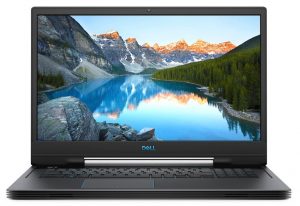
For every test like this, we use the same video in HD.



CPU options
You can pick either the 8th or 9th Gen Core i7 H-series processor – the Core i7-8750H and the Core i7-9750H, respectively.
Results are from the Cinebench 20 CPU test (the higher the score, the better)
Results are from our Photoshop benchmark test (the lower the score, the better)
GPU options
If you are more on the budget and don’t need the ray-tracing enhancement goodies that the RTX GPUs provide, you can go for the GTX 1660 Ti. Otherwise, you can pick the RTX 2060 or the Max-Q versions of the RTX 2070 and RTX 2080.
Results are from the 3DMark: Time Spy (Graphics) benchmark (higher the score, the better)
Results are from the 3DMark: Fire Strike (Graphics) benchmark (higher the score, the better)
Results are from the Unigine Superposition benchmark (higher the score, the better)
Lenovo Legion Y740 (17") GPU variants
Here you can see an approximate comparison between the GPUs that can be found in the Lenovo Legion Y740 (17") models on the market. This way you can decide for yourself which Lenovo Legion Y740 (17") model is the best bang for your buck.
Note: The chart shows the cheapest different GPU configurations so you should check what the other specifications of these laptops are by clicking on the laptop’s name / GPU.
Results are from the 3DMark: Time Spy (Graphics) benchmark (higher the score, the better)
Results are from the 3DMark: Fire Strike (Graphics) benchmark (higher the score, the better)
Results are from the Unigine Superposition benchmark (higher the score, the better)
Gaming tests

| Far Cry 5 | Full HD, Normal (Check settings) | Full HD, High (Check settings) | Full HD, Ultra (Check settings) |
|---|---|---|---|
| Average | 108 fps | 100 fps | 93 fps |

| Rise of the Tomb Raider (2016) | Full HD, Medium (Check settings) | Full HD, Very High (Check settings) | Full HD, MAX (Check settings) |
|---|---|---|---|
| Average | 134 fps | 70 fps | 45 fps |

| Tom Clancy’s Ghost Recon Wildlands | Full HD, High (Check settings) | Full HD, Very High (Check settings) | Full HD, Ultra (Check settings) |
|---|---|---|---|
| Average | 82 fps | 71 fps | 47 fps |

| Shadow of the Tomb Raider (2018) | Full HD, Medium (Check settings) | Full HD, High (Check settings) | Full HD, Highest (Check settings) |
|---|---|---|---|
| Average | 85 fps | 80 fps | 52 fps |
Temperatures and comfort
Max CPU load
In this test we use 100% on the CPU cores, monitoring their frequencies and chip temperature. The first column shows a computer’s reaction to a short load (2-10 seconds), the second column simulates a serious task (between 15 and 30 seconds), and the third column is a good indicator of how good the laptop is for long loads such as video rendering.
Average core frequency (base frequency + X); CPU temp.
| Core i7-9750H (45W TDP) | 0:02 – 0:10 sec | 0:15 – 0:30 sec | 10:00 – 15:00 min |
|---|---|---|---|
| Lenovo Legion Y740 17″ | 3.31 GHz (B+27%)@ 93°C | 3.35 GHz (B+29%)@ 93°C | 3.00 GHz (B+15%)@ 80°C |
| Acer Predator Helios 300 15 (2019) | 2.98 GHz (B+7%)@ 63°C | 3.03 GHz (B+18%)@ 68°C | 2.98 GHz (B+10%)@ 72°C |
| Lenovo Legion Y540 | 2.78 GHz (B+7%)@ 74°C | 3.08 GHz (B+18%)@ 90°C | 2.87 GHz (B+10%)@ 79°C |
| ASUS ROG G731 | 3.38 GHz (B+30%)@ 87°C | 3.43 GHz (B+32%)@ 94°C | 2.63 GHz @ 73°C |
| ASUS ROG G531 | 3.41 GHz (B+31%)@ 95°C | 3.23 GHz (B+24%)@ 95°C | 2.72 GHz (B+5%)@ 79°C |
| HP Omen 17 2019 | 3.44 GHz (B+32%)@ 86°C | 2.74 GHz (B+5%)@ 71°C | 2.67 GHz (B+3%)@ 71°C |
Well, well, well… Six cores proved to be pretty hard to cool down, yet again. The test began pretty comparably to how the stuff went on with the ASUS ROG G731. This basically means – high frequencies at very high clock speed. Despite the similarity at the beginning of the torture test, at the end of the day, we saw a pretty different result – the Legion Y740 17″ was working at 370 MHz higher and around 7C also higher. It is up to you to choose whether it is worth it for you. What we should not, though, is that the HP Omen 17 2019 was working at a very close temperature to ROG G731, but with very, very low fan speeds.
Real life gaming
| NVIDIA GeForce RTX 2070 Max-Q | GPU frequency/ Core temp (after 2 min) | GPU frequency/ Core temp (after 30 min) |
|---|---|---|
| Lenovo Legion Y740 17″ | 1269 MHz @ 76°C | 1236 MHz @ 80°C |
As we don’t have a configuration to compare the Legion Y740 17″, since it is the first laptop with the RTX 2070 Max-Q we’ve tested, we can’t show you any direct competitors yet. However, we know the maximum Boost frequency it should be able to reach – 1305 MHz. Honestly, the Legion Y740 17″ wasn’t that far away from that value but at the end of the test, the core was reaching 80C.
Gaming comfort
The Legion Y740 17″ was not louder than most of the gaming laptops we have tested. Temperature-wise, the hottest spot was 48C – just below the “5” key.
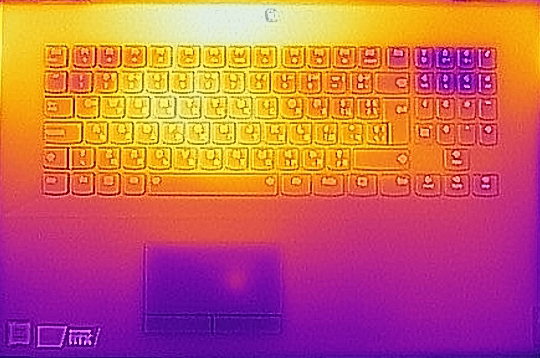
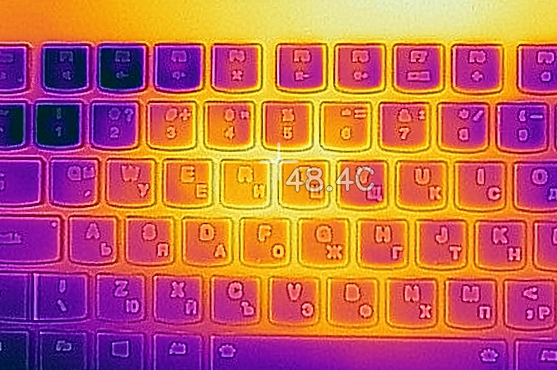
Verdict
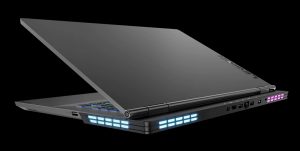 The Legion Y740 17″ is built for gamers that are not all in the aggressive looks or the gold, red and black combinations. No, in fact, the laptop is combining silver with a somewhat industrial design and a pinch of blue as a backlight on various places. Of course, there is the RGB keyboard, but it looks ever so subtle on this chassis.
The Legion Y740 17″ is built for gamers that are not all in the aggressive looks or the gold, red and black combinations. No, in fact, the laptop is combining silver with a somewhat industrial design and a pinch of blue as a backlight on various places. Of course, there is the RGB keyboard, but it looks ever so subtle on this chassis.
We’re also pretty happy with the camera placement this time. Thankfully, Lenovo was not foolish enough to have plenty of space all around the display, and still, put the camera below it. Or even remove it, as some manufacturers that we won’t name… like ASUS. Sadly, the battery life is poor here – less than four hours of Web browsing and around three hours of video playback.
Nevertheless, it’s time for what you’re all here – the performance. If you are in the market for more performance, we would recommend going for a full-blown RTX 2070 experience, and a device that is going to provide you with such, while producing very little noise – is the HP Omen 17 (2019). On the other side – the difference between the RTX 2060 and the RTX 2070 Max-Q, especially inside the Lenovo Legion Y740, is so negligible, that you would want to go for the RTX 2060, instead.
By the way, in order to get the full experience when gaming, you don’t only need good hardware – you need both a fast and punchy display and comfortable input devices. First, there is the 144Hz Full HD IPS panel (LG LP173WFG-SPD2 (LGD05E0)) – it has a great contrast ratio and comfortable viewing angles. Moreover, it is rather safe, by not implementing PWM to adjust its brightness levels. What we were more interested in, though, was how it deals with the colors. In terms of displaying them to you – it can show you 96% of the colors found on the Internet, and with its default settings, we can say it is pretty decent in the accuracy. However, when you apply our Gaming and Web design profile, the average dE slumps down to 0.9 (which is very color accurate), providing you with the opportunity to use the device for Web design. Sadly, though, we don’t think you would really love the keyboard and obviously, if you are playing games you’d connect an external mouse.
However, we suggest connection an external keyboard as well. This lack of amusement of the built-in keyboard of the Legion Y740 17″ comes from the shallow key travel. Yeah, sure, it is good enough for typing, but it is not satisfactory for gaming.
On the other side, the I/O is great, as it has everything you need (except an SD card slot, though). We’re especially happy with the Thunderbolt connection that can’t be seen on the more budget Lenovo Legion Y540.
Pros
- Good build quality with a huge ventilation grill on the bottom
- Sleek non-aggressive design
- Supports Thunderbolt connection
- 144Hz Full HD display with wide color coverage and great color accuracy (when our Gaming and Web design profile is applied) (LG LP173WFG-SPD2 (LGD05E0))
- Doesn’t use PWM to adjust its brightness levels (LG LP173WFG-SPD2 (LGD05E0))
Cons
- Uncomfortable keyboard for gaming
- Poor battery life
- Lacks an SD card reader
You can check the prices and configurations in our Specs System: https://laptopmedia.com/series/lenovo-legion-y740-17/
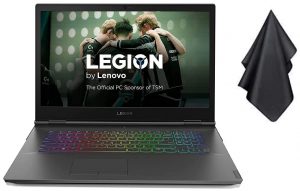


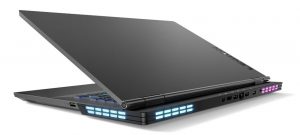

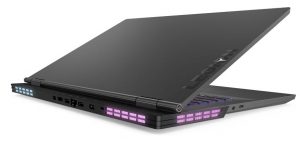
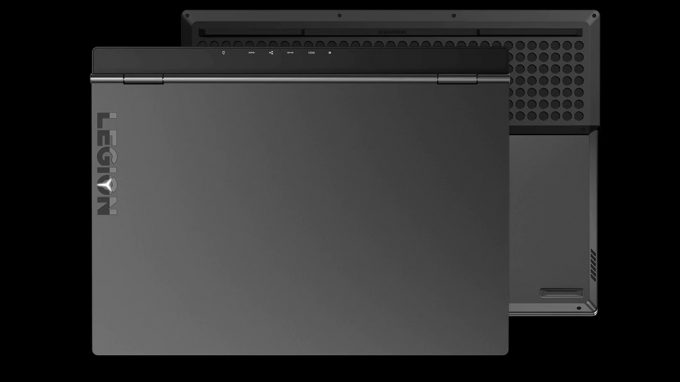
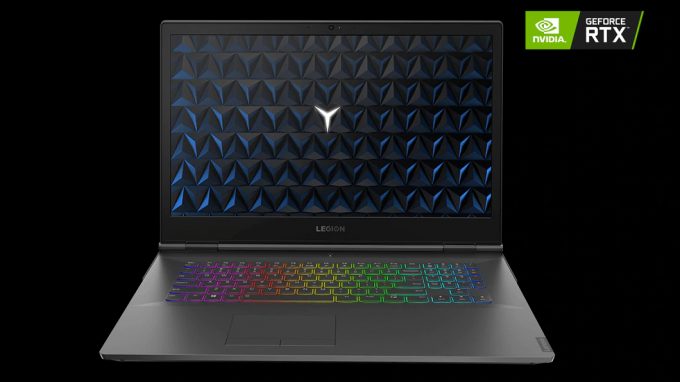


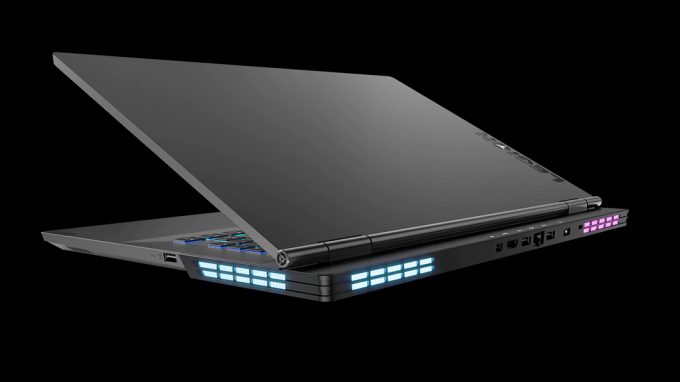

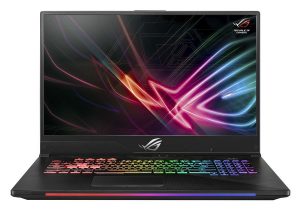
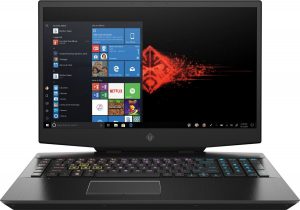








Lenovo designs gaming laptops increasingly beautiful